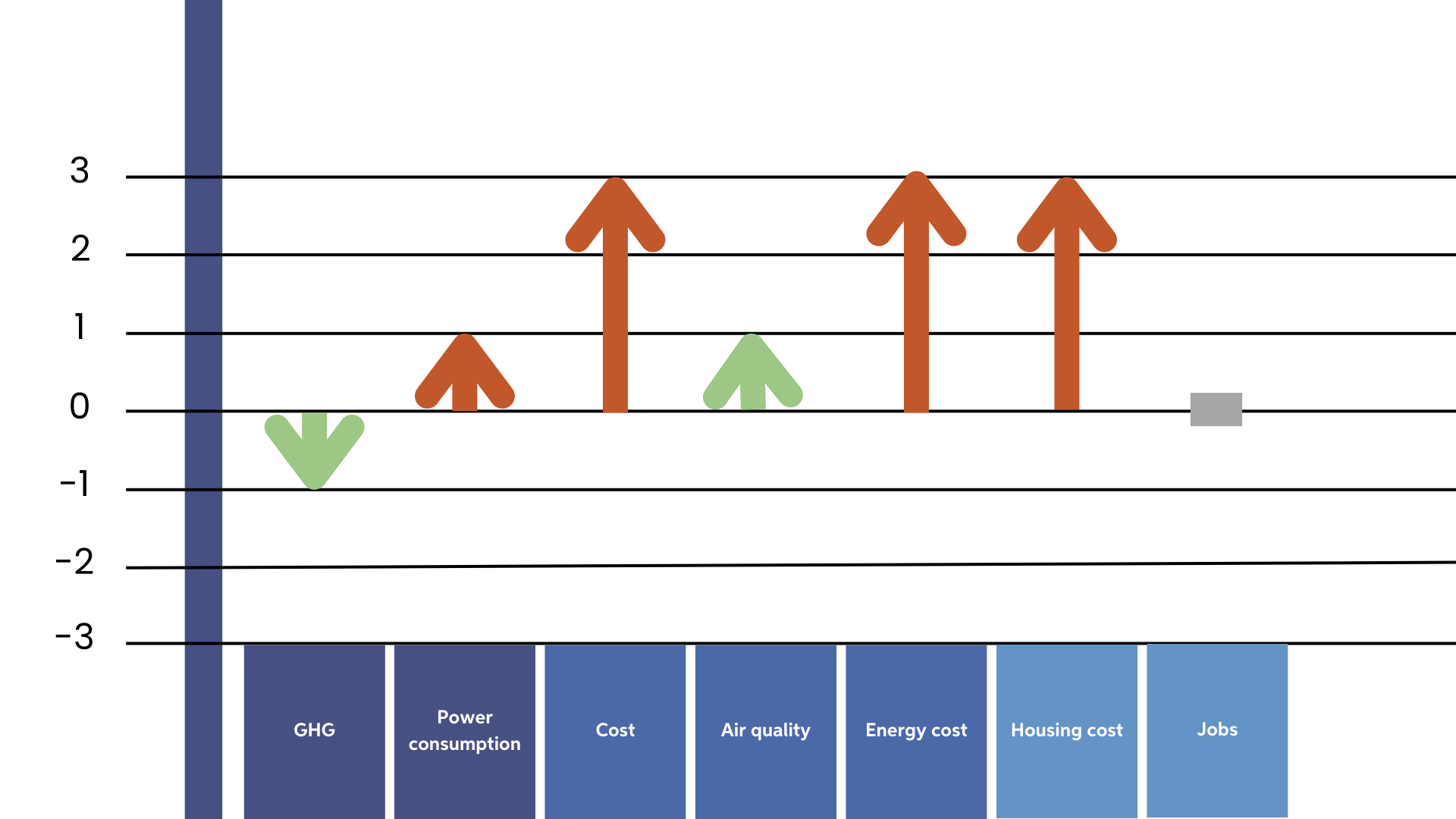
Coping with Gridlock
To analyze how each scenario affected outcomes important to Impact 2045, we created a list of indicators to use to “score” our scenarios. These include greenhouse gas emissions, energy consumption, cost of implementation to municipalities, and indicators related to the key LIDAC burdens we identified as significant in New Haven County. Linguistic isolation and unemployment were represented as workforce development needs;, the need to address asthma was captured in the category of air quality, and energy costs and housing costs were considered as their own standalone indicators.
On a scale of -3 to +3, each scenario was ranked across these indicators to capture the outcomes present under different conditions. The arrows in show whether an indicator increases or decreases in a scenario, and the color indicates whether the change is beneficial (green) or harmful (red). This analysis helped us understand the needs and challenges in each scenario in relation to our strategies.
While general trends towards carbon-free technologies continue, important legislation and funding initiatives do not materialize.
For example, the three-state wind agreement does not materialize in tangible projects and Connecticut fails to meet certain clean energy goals (Associated Press, 2023). Moreover, current equity issues with efficiency and renewable incentives continue, with programs aimed at decarbonizing the building and electricity sectors not meeting the needs of renters and low and moderate-income homeowners (Heeter et al., 2021; Ramanan et al., 2021). In the state capitol, the legislature fails to take certain policy measures that give DEEP the authority to tackle important climate measures, such as setting enforceable goals for GHG emissions (Spiegel, 2023a). Additionally, the issue of food waste continues to be handed off to regions and municipalities (Spiegel, 2023b). As the state flounders, so does Washington. Political gridlock worsens as climate change remains a wedge issue between the country’s main political parties (Astor, 2023). Funding opportunities dry up as Congress fails to build upon the successes of the two back-to-back infrastructure bills (Carbon Brief Staff, 2022) Federal involvement in wind energy falters, as successive executive branches fail to approve much needed projects along the eastern seaboard. Moreover, high interest rates continue to slow the buildout of projects in this sector (Wasser, 2023). The future of Connecticut's grid is uncertain.
In response to these changes, the onus of climate change mitigation falls onto the towns and cities of New Haven County. Limited funding and current climate planning paradigms perpetuate regional inequities related to mitigation efforts (Balta-Ozkan et al., 2015). Private efforts to address climate change fail to address equity issues, while important burdens such as energy costs continue. Local power is entrenched and competition for funding is an ever-present reality in the County. However, Sustainable CT does increase its support of communities looking to implement mitigation measures (SustainableCT, 2023a). For example, the city of New Haven continues to serve as a gold certified community in the county (SustainableCT, 2023b). These efforts are supported through private and philanthropic investment, which capitalize on the energy transition and lack of state and federal guidance on the matter. These take on an increasingly technocratic approach, as the usage of technologies such as smart grid systems becomes more common. In much the same way, local organizing becomes even more engaged with moving towards a sustainable future for the region. The people are frustrated with the lack of state and federal support and the popularity of innovative, small scale mitigation solutions increases. While this is important, the cost of these efforts remains a concern within popular conscience. However, costs related to fossil fuels have risen as well, as global efforts to divest from the fossil fuel industry have increased costs for energy (Black, 2023). The costs of renewable technology may still be a concern, but the cost of fossil fuels is simply too great for many in the county. In conclusion, this scenario represents a future where legislative efforts at the state and federal level fail to deliver on important measures that would support mitigation efforts if New Haven County, while businesses, non-profits, and citizens become more active in the fight against climate change.



